#she's so involved in casteism
Explore tagged Tumblr posts
Text
and that's why i never hang out with her even after being in same friend group her beliefs her actions make me so nauseous and i don't want to speak about her because it's like weighing down my tongue and i try to maintain my distance but its an exam tomorrow and i was bit anxious and only one day was enough for her to attack me
#she's so involved in casteism#has gone out (as in taken nightstays at hotels) with not just one fucking uncountable seniors without taking hostel leave in secrecy#she's obsessed with guys keep on begging for anyone's attention and will leave all her girl friends stranded for them#i did not have to say this but you get her personality#she's way more pathetic in things i can't make you count on fingers
3 notes
·
View notes
Note
Has anyone asked you about erisol?
If no, then what's your opinion on them! :-)
I feel like people will be upset at me for this, but a completely platonic and completely lukewarm mutual dislike... they don't really like each other, but take no great issue with each other either. The boys are not fightingggg
So like. A common thing in fandoms is taking things at face value and not really reading any deeper into them. You see this a shitton with Eridan in general - lots of people take it 100% at face value that he's a casteist genocide liker, when it's pretty clear upon further examination that he's pretty much lying about being casteist and doesn't actually want to murder his friends. So, at face value, Eridan hates Sollux, and either wants to do spadesies with him, or go ashen with him. And so this has become a really popular ship, but the thing is... at basically every turn, the story kind of goes out of its way to point out that there's actually nothing between them. At least romantically.
See, Eridan does not actually hate Sollux, at least not to the level of pitch/ashen. TWICE before Sollux and Feferi start hanging out all the time, we see Eridan commenting on Sollux in a fairly neutral-negative way - the first time calling him "a drama machine" and noting that "it is fuckin pathetic," and the second time as "the dead guy who saved [Feferi]". And let's be clear about the former, Eridan is just kind of Like That, he's rude as fuck even about people he LIKES (calling his BFF Karkat an "assblood" and sarcastically referring to Feferi by her royal titles), so that's actually one of the less nasty things he's said about someone.
Meanwhile, on Sollux's end, he LITERALLY says "not interested" to what he perceives as pitch/ashen advances from Eridan. Like, actually just says those words out loud. Not even in a pesterlog, he actually just says those words with his mouth.
So it seems to me that there's a pretty clear case to be made here that Eridan and Sollux kind of just... don't really give a shit about each other, and probably wouldn't have interacted in any substantial way if not for Feferi's involvement. Especially because Eridan's chosen method of hitting on Sollux is with casteism, something he's already faking in the first place.
If we really want to dig into this, though, it's kind of - in my eyes - a lukewarm case of the hedgehog dilemma. They're a bit too similar, and it winds up causing them both mild pain to get too close.
They're both nihilists that kind of hate themselves. Sollux's mutated brain causes him a not-insignificant amount of discomfort, his visions of the future and of the "imminently doomed" have made him lose a lot of hope, and he blames himself for killing Aradia, something so painful that he didn't tell anyone else she died, to the point where most of the team - including Terezi and Tavros - had to find out after entering the game. Meanwhile, Eridan struggles with the perceived inevitability of a lifestyle that causes him nothing but distress, and his constant, overwhelming anxiety about it leads to constant stressing over whether or not he's "good enough"; whenever he's in severe emotional distress, he starts beating up on himself.
They also both front at being more okay with their problems than they actually are. Sollux has his 1337 hacker, two cool for you persona that he puts on, and Eridan is always trying to be the big bad sea dweller. For example, Sollux goes "I'm not trolling the humans, it's beneath me," but he's in Jade's trollslum, so the implication there is that he totally did try trolling, it went badly for him, and now he's pretending that he was always better than that. And I don't think I need to tell you how hard Eridan works to try and present himself as badass and scary and totally not deep in the throes of emotional anguish at all times.
And these are the similarities that ultimately make Erisolsprite so stable. Erisolsprite speculates that maybe the reason he hasn't exploded yet is that deep down, he loves to suffer. The truth is, there's nothing between the two that's really so objectionable that they would ACTUALLY hate each other; Eridan isn't actually casteist, and Eridan never really hated Sollux in the first place.
Neither would they bring each other any comfort or joy - Eridan doesn't have any sympathy for Sollux's baggage, since, like, what, he only killed ONE person, and was even under mind control, so it's not like it was really his fault. He's a drama machine. And Sollux wouldn't have sympathy for Eridan's problems, partially because they manifest in such cringeworthy, embarrassing ways (and Sollux is highly sensitive to not being cringe, seeing as he's always commenting on other people being embarrassing or overly earnest), and partially because - I mean, fuck it, he's a rich-ass sea dweller who doesn't need to worry about being harvested to be a battery for a living ship. And also he's an idiot.
That's kind of what their relationship is to me, you know? A tepid and lukewarm dislike. They're just similar enough to each other to understand the other, and just different enough to be like "ugh, but that guy suuuuuuuucks". It's very funny, but not really a ship, hahaha.
So what you really get from that is two guys that just kind of dislike each other. Not vehemently or diametrically enough for pitch or ashen, and not a trace of the requisite pity for flushed or pale. When you throw the two together into one sprite, it won't shut up about how much it hates itself, how each part of itself is flabberghasted by the other, and how much practically the only reason it doesn't explode is a resounding "meh."
Eridan likes to validate his despair; ironically, since it's all he's ever known, it's where he feels comfortable - and nobody would provide better doomscrolling material than the doom player. Similarly, Sollux likes to torment himself, suffering his guilt in silence, and Eridan has SO MUCH to feel guilty over. Combine them into one entity, and you have a guy who can reach SUCH levels of revelling in his own misery, you don't even KNOW.
Not that it's healthy or positive for either of them... just that it would be incredibly stable. It's their worst tendencies being satisfied by each other. Maybe that's a form of leprechaun romance, but it's certainly not a quadrant.
#homestuck#eridan ampora#sollux captor#admittedly sollux is one of the trolls i'm still working on grasping#and this post should also in no way be taken as 'stop shipping them' because idfc#ship what you want who cares hussie has already been driven away with jeering and sneering#i just was always kind of fascinated by the endurance of the ship#despite pretty much every piece of canon involving these two pointing to the fact that they just. kind of dont like each other#but in a platonic way
132 notes
·
View notes
Note
Speaking of Marcy’s approach to Amphibias politics, she’s probably the most competent person in the newtopian government(fixing the sewer system, rescuing civilians, supporting farmers, and is down for societal reforms)
Ah the only shitty politics I'll ever talk about on this blog ✨racist newts✨
Speaking of newt politics...

Idk it's just...vague what Marcy exactly thinks of the system itself I just feel like I can't make a direct call on this, it's so left out open ended in the journal too. Plus all with how she values farmers as underappreciated backbones of society
I agree Marcy is the only competent person with a braincell in this government. I doubt how much she involves in them at all though. Surely theme song takeover shows she even writes royal verdicts while Andrias snoozes and all that
In tc her response to the toad rebellion is to 'redesign the political system' and make sure 'this kind of uprising never happens again.' Her first instinct is the approach she took for Wartwood, changing the political system overnight like fixing sewers, part of me wonders Marcy even has a clue why the rebellion happened to begin with. She doesn't know Andrias purposefully made things this way, she knows what Andrias lets her see. She has faith she talk him out of changing things.
Yet somehow there's still the ranger oath that tells her a newt's life should matter above the rest—
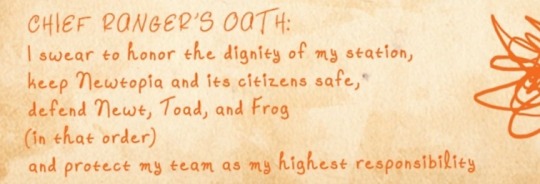
Should've been her first red flag if I were honest. She knows casteism exist she doesn't understand the problems of it bc the newts don't make it out to be. Let's admit, she's 13 freaking years old. The journal also shows she was actively being kept away from learning truths.
Toad to Redemption is one episode that talks about the oppression on toads by Newtopian authorities, and my biggest focus here that Marcy is still in Wartwood while this happens. Coincidentally, she's purposefully made busy in an outhouse with Frobo for this very episode. This is one of the weirdest things to me bc it's like the show itself is trying to keep her in the dark and short-sighted. Keep her from having reasons to question her faith in Andrias.
She has been limited to the ruling class view in this new world. And that makes sense because it was one of the things that could perhaps bring her to disagree with the King, had she seen the other side of the story.
#not my best explanation but i think i made my best attempt idk#it's... complicated#struggled to find the oath screenshot so much lol but I knew i remembered it correctly#amphibia#marcy wu#andrias leviathan#marcy's journal#amphibia politics#character analysis
44 notes
·
View notes
Text
I've seen people on all sides say that the stolitz conflict is entirely based on their Class&Species difference (honestly it's not a perfect or unproblematic fit, but I think that casteism is the closest real world equivalent we can use to wrap it up in one word only) and that the show isn't concerned with integrating homophobia into it, but I want to poke at this notion with a stick, at least where Stolas is concerned. Though I do agree that it's not a focal point, but rather a predictable outcome of how the Goetia family is seemingly structured......
-----------
K I've had this post in my drafts for an embarrassing amount of time, and the plan was to expand on it at some point, but since that never seems to happen. Shitty very bad no good graphic tldr be it

-----------
K pt 2 because despite everything the yaptron instincts never allowed me to hit post to this, but I'm leaving ⬆️ in because it's funny. to me. In the end these are more observations about the Goetia family in general than on Stolas' specific situation, but anyway


The idea that lacking ~virility~ makes for a lesser man is, indeed, rooted in all those fun things on the left of my silly little tldr (yes, the misogyny bit too. A man as we traditionally envision him, degraded and thus assimilated to femininity as we traditionally envision it, women, the horror!). Like this post could have ended here, this is literally homophobia both in its sentiment and in its target, coated with that good old gender stereotyping and bigotry


Same with the expression of Feelings and Emotions. The expectations of how people in power are supposed to behave generally go hand in hand with a number of things that are expected specifically out of men, because those two things (power and men) have been going hand in hand since the dawn of time
And and and. Paimon. The idea of the pater familias with full authority over his children's lives (and those of the other members his family, and of his subjects)...... for all intents and purposes, their ruler and owner. Very patriarchal, very crunchy


I'm also going to disagree with the notion that Stolas' affair with Blitz was only a problem due to their Class&Species difference. Stella's a character who's profoundly concerned with self-image and reputation, true, but in light of everything else... because of it even, yes I do imagine that the Goetia family would indeed have thoughts about someone trying to break free from their mould, indirect involvement of an itty bitty imp or not. Marriage and monogamy do have a seat up there in uh oh girl, the Patriarchy and its historical expressions



Re: Stella. Obviously family members are bound to come with a certain degree of... well... familiarity. But I think it's Interesting.jpeg how Andrealphus can casually belittle and talk down to her despite her technically outranking him (I think? A princess consort is above a marquis, surely?), if only because her general demeanour points to someone who wouldn't put up with something like that, at all. That same familiarity and whatever upbringing she had leave her open to his manipulation, but I do wonder about the treatment of women in the Goetia family in general...... *looks at "your purpose in life is to be an incubator for that guy"*. Mhn. The prospects seem bad. Also. We don't know what/who Andrealphus might be hiding back at home, but there's some juice in thinking about how he might be more free than Stolas - sexually speaking - by virtue of his apparent lack of obligations to the Goetia family......
Tldr of the tldr, even if so far helluva boss hasn't been outwardly interested in addressing some aspects of Living In A Society, those aspect do have a foundational presence in the story. Eg we won't see Stolas or any other gay bird actually get hate crimed at ball n.204471, and a character like Stella was probably not written with "homophobic" as one of her traits in mind (see: she doesn't comment on Blitz's gender; possible underlying horrors aside, clearly Andrealphus isn't otherwise an issue for her), but...... They Live In A Society
#helluva boss#stolas of the ars goetia#stella of the ars goetia#i suppose that this is also a stolitz post but like. only marginally so#mytext#series#andrealphus of the ars goetia#paimon of the ars goetia
6 notes
·
View notes
Text
i started reading up on the matrikas and tantric goddesses in hinduism
and i think the raddest has to be Matangi.

this right here is matangi. in simple terms, she's Saraswati's tantric form and one of the ten Mahavidyas.
she was formed from the leftovers of the food that the gods had at a feast, and Parvati had declared her as a goddess in her own right.
or she could also be the chandalini (women who work at the crematorium) form of Parvati when she had sex with Shiva which involved role-play.
or she could also be the casteist sister of Shiva, called Kauri-bai. Parvati cursed her for her casteism to herself be born as those she considered "low caste" to teach her a lesson. Shiva then made her a goddess, and no visit to Kashi today is complete without worshipping Kauri Bai.
as such she's associated with pollution and all things which are considered impure in classical Hinduism, and is extolled as the goddess of dalits and adivasis, and thus is a symbol of equality and the fact that knowledge and learning is unrestricted. she is offered the leftover prasad as offerings instead of freshly cooked food, a reminder of her origins.
she is green in colour and she sparkles and she is constantly high. she controls the material aspects of the arts and learning and speech, while Saraswati controls the more philosophical and spiritual parts. she also represents the 64 arts. she also is the goddess of the throat chakra. oh and it is said worshipping her gives you magical powers, specifically telepathy and mind control.
honestly she is so cool.
117 notes
·
View notes
Text
oh I forgot to do this
Hs au moment
ok so basically this kind of "swaps" the political systems of Alternia and Earth with each other. How does that work if humans inly have one blood color? this is where is gets funny and evil bc. it doesn't. everybody is just violent. at some point in time complete anarchism and moral death happened and Earth just became some kind of apocalypse except it was a "By humans, for humans" kind of deal.
Eventually someone makes an army and fights their way to power and somehow takes over the world?? maybe they invented guns when no one had them. like what are you going to do against someone with guns? what matters is that after that, society advanced a lot but it was still super violent bc there's no way the (descendants of the) guy who took over the world is actually overseeing everything. not that they’re trying to, really
How does this affect the kids? well, for one they’re anger bite maim kill. like imagine you go to school and you literally have to fight for your life sometimes. there is 0 chill ever. except for like Jade who’s still kind of the same? but her grandpa was not that much of a good person and she got a bit from him so she’ll hesitate less to go feral on others. anyway, they’re all still friends but their humor is a lot more based around saying they’ll kill each other and and in the more serious “are we really even friends moments” they go “yeah well I wouldn’t hurt you on purpose ever. just so you know”.
MEANWHILE in Alternia, Doc Scratch just. did not. at least I think it was Doc Scratch who caused Alternia to be the way it is? either way, all you have to do here is slap our political system on them and then like, turn casteism into a much less present thing. like, it’s still THERE and still an issue but they have actual rights and killing them is actually a crime. Changing the setting like this causes the trolls to be way more chill than they are in canon, though most of the relationship issues (involving physical damage or not) still happen one way or another.
the resume of this is that the trolls get on the meteor and are like “oh woah cool alien race let’s see what they’re OOOOH MY GOD HOLY SHIT WHAT THERE’S A CITY ON FIRE OHHH NO” and after a while when they finally talk to the humans they’re like “bro. bro that shit’s so normal what are you on about there are 0 issues here” and basically the meteor becomes therapy arc when the humans get there.
#homestuck au#this was way better in my head but whatevs#I didn't explain it well at all but. shrug.#homestuck#idk if I actually want people to see this so I'll just kind of leave it with these tags
5 notes
·
View notes
Text
BUILD ME A CANON
Earlier this week, Delhi University's Oversight Committee removed works by writers Bama, Mahasweta Devi and Sukirtharani from the university's syllabus for undergraduate students of English. Bama and Sukirtharani are Tamil Dalit writers whose work looks at the experiences of the marginalised. Mahasweta Devi, a Bengali writer, was well-known for her Left-leaning politics and for being an advocate for tribal communities and their rights. She passed away in 2016.
I'd suggest one moment's silence for the Oversight Committee committing an oversight, except this is not an oversight. An oversight is an unintentional mistake, but this seems very intentional. As the DU clarified in a statement later, "the syllabus of the course has been passed through a democratic process with the involvement of all the relevant stakeholders and necessary deliberations at appropriate forums” (emphases mine). The university claims the English syllabus is suitably diverse and inclusive (suitably being the key word here) and it's interesting that as part of its defence of the Oversight Committee's decision, DU has pointed out the process of coming to that decision was "democratic". What it doesn't acknowledge is that if the committee is full of people who belong to dominant groups and doesn't have members who represent the minorities and the marginalised, then the committee's "democratic process" is critically flawed.
The DU statement came after the Academic Council submitted a dissent note, protesting the Oversight Committee's decision. The Academic Council described the Oversight Committee's functioning as vandalism and alleged it has been harassing liberal arts departments. "It is important to note that the Oversight Committee does not have any member from the Dalit or the Tribal community who can possibly bring in some sensitivity to the issue," said the Academic Council in its note.
There was some noise on social media about the decision to drop works by these three writers. Most of the discussion that I saw was about Mahasweta Devi's dropped short story, Draupadi. (Apparently the Oversight Committee chair complained the short story doesn't show the military in a good light. From what I remember, it's the police. They carry out wrongful arrests and brutally gangrape a tribal woman.) There's been far less discussion of Bama and Sukirtharani's works on English Twitter, who have mostly been referred to as the "two Dalit writers", like an addendum to Mahasweta, which is infuriating in itself. I know that this is probably because not enough people read translations. Particularly translations of literature from Indian languages.
There is also little talk about what has replaced the dropped works. One of the authors who has been included is apparently Pandita Ramabai, identified as an upper caste writer (Brahmin, if I'm not mistaken). I've no idea if her writing continues to feel relevant and/ or engaging, but it is all sorts of bizarre to "replace" a 20th century author with someone who died in 1922. Also, if she was included because she was Brahmin, I hope they have fun reading her book The High Caste Hindu Woman which is, I'm told, deeply critical of how sexist Hinduism. Whether or not Pandita Ramabai voiced any opinions of casteism in Hinduism, I don't know.
Even though translations don't get read as much, the fact is, the writings of Bama, Mahasweta Devi and Sukirtharani have been translated to English and other languages. They're part of different university's syllabi and for better or for worse, DU is not such an influential player in academia. If DU's decision to drop these writers convinces some Indian universities to do the same, we can only hope that other universities (in India and abroad) will start thinking about including them in their syllabi (if the writers aren't in them already). In a not-so-distant future, it's very likely that there will be universities abroad that will have a more diverse, inclusive and representative portrait of Indian culture in their syllabi while institutions like DU remain mired in a casteist, Hindutva bog. At that point, who should decide what will make the canon for Indian literature? The Indians or the foreigners?
It's the second time this week that we've heard conversations about erasure in the Indian cultural scene. Earlier this week, social media was on fire after the Indian edition of the Rolling Stone carried a cover story about the record label and music platform Majja, featuring two artists best known for their collaborations with Dalit rapper and lyricist Arivu. Rumour has it that the Rolling Stone cover was bought by Majja, presumably to promote upcoming albums by those two artists. However, since Dhee and Shan Vincent de Paul are currently riding a popularity wave because of their work with Arivu, many readers — beginning with director Pa Ranjith — expected the cover story would be as much about Arivu as Dhee and Shan Vincent de Paul. People also pointed out that Arivu had effectively been removed from a (disastrous) remix of "Enjoy Enjaami" (the original song is amazing).
Shan Vincent de Paul, one of the artists featured on the Rolling Stone cover, issued a statement on social media saying he had the utmost respect for Arivu and had no intention of erasing him. He clarified that the story was part of his efforts to promote his new album Made in Jaffna, which he's releasing with Majja. "I have no control over how the Press chooses their messaging or what narratives they push," de Paul wrote, which would be an excellent point if the cover wasn't bought. He may not have control over the narrative, but he's hardly an irrelevant cog in the wheel. Instead of attempting to exonerate himself, de Paul could have acknowledged that the story doesn't give as much space to Arivu as it should. I am, of course, presuming he's read the story.
If the rumour about the cover being bought is true then Rolling Stone and Majja are complicit in deciding a narrative that sidelines Arivu, either intentionally or carelessly. More than half of Rolling Stone's cover story is about "Enjoy Enjaami" and there is just one quote from Arivu. This sidelining may not be deliberate — the way DU's Oversight Committee's decision was — and it could be an example of the kind of unthinking oversight that the privileged commit all the time when it comes to acknowledging the contribution of the marginalised. Either way, the impression conveyed by the two organisations is that Arivu is not the person they want to promote. Countering the decision of the establishment — it doesn't get more establishment than Rolling Stone and Majja. One of Majja's founders is legendary music director AR Rahman — is the reaction on social media. The songs being freely available on multiple platforms and the (relatively) free access to the artwork and arguments by Dalit creators and critics on social media makes it difficult to invisibilise Arivu.
A translation of Mahasweta Devi's Draupadi is available online as are some of Sukirtharani's poems. DU has dropped Bama's novel Sangati. I'm not sure if there's an extract that's available online. It is not lost on me that it's easier to listen to a song than it is to read a novel, or a short story, or a poem. It is also not lost on me that the fact you can bob to an infectious beat makes it easier to not register the deep-rooted casteism referenced in the lyric, "Enna kora, enna kora, yein chella peraandikku enna kora? (In what way is my darling grandson any less?)" There are no such distractions when you read, for example, Sukirtharani's My Room Needs No Calendar: "As they write on me/ with their penises,/ I will my body to stop/ slithering away."
Sukirtharani and Bama minced no words when they were asked to respond to their works being dropped from the DU syllabus. "I was not surprised at all. Dalit voices such as myself and Bama’s are speaking for all oppressed women, not just Dalit women," said Sukirtharani. "I don’t see this necessary as an exclusion of just Dalit writers as we have seen how progressive writers whose works speak against caste, Hindutva, fundamentalism have also been removed in the recent past. These things will happen in our society, but we cannot be ignored." She said she wasn't going to ask for an explanation, but believed DU owed her an explanation. At the very least, they should have intimated her about the works being dropped. "When they want to project an image of India wherein there are no caste and religious inequalities, our works point out that caste and religious inequalities exist in our society. So, it is obvious that they want such works removed from the syllabus," she said.
Bama said, "For more than 2,000 years, we have been segregated, our histories have not been written. This government is trying to strangulate our voices, but we will shout. The youth of this nation have understood [what is happening]. Rather than being upset, we are angry. The anger will reflect in our works in future.”
I find myself wondering if the business of building a canon was always so complicated and rife with uncertainties. Will the books, music and art propped up by commerce and politics be the ones that make up our mainstream cultural identity? Could we build a better literary canon for Indian literature if more excerpts and poems were available online for free, if more works were translated? Would we care more if the literature was easier to access or would we still dismiss it because they're translations, because the works are by Dalit women? Can the conversations that we hold in the informal spaces of the internet be loud enough to make the canon more inclusive, to make the mainstream expand its narrow definitions? What is more likely to make it into an archive and survive into posterity — the Rolling Stone Cover image or the many "fixed it" versions that people created online? Is it possible that both can and will be preserved? Does dropping the works of writers like Bama and Sukirtharani and Mahasweta Devi make them invisible? Will the dissent make a few more people buy Bama's novel? Will it make some curious enough to look up Sukirtharani's poems?
The words, the tech, the platforms, the imagery — are all these still the master's tools? How long must one wield them before they can claim the tools to be theirs? Will they always be the master's tools and not "our" tools? Is the master the one who cares for the tools and uses them better? Is the master the one with the loudest voice and the deepest pockets, the one who can bribe the boys and hire the deadliest mercenaries? Who decides when the tools have been reclaimed?
#Building a canon#Indian academia#Life in a progressively undemocratic country#Arivu#Bama#Sukirtharani#Mahasweta Devi#Indian literature#Culture and identity#Rolling Stone#Music#Enjoy Enjaami
14 notes
·
View notes
Link
June 21, 2021: Queerism by Pragya Pallavi
Pragya Pallavi’s 2019 album Queerism may be the first openly queer album released in India, which is an impressive feat for many reasons, but most notably because at the time of the album’s release, homosexuality had been decriminalized in India for less than a year. The anti-homosexuality part of Section 377 of the Indian Penal Code, which was instituted in 1861 during the British colonization of India and criminalized sexual activities that were “against the order of nature”, was repealed on September 6, 2018, with Justice Chandrachud referring to the section as an “anachronistic colonial law.” However, as this Medium interview with Pallavi states:
Repealing of section 377 is “just the beginning” for Pragya, and there is still a “very long way to go”. Although homosexuality is now legal in India, people in the country are still far from accepting, and instead many persist in “living life with old thoughts and dogmas”. She says that the British empire definitely inspired “transphobia and homophobia” but patriarchy, casteism and other power differences also have influenced hostile attitudes towards LGBT+ people. Pragya cautions that “this new victory” should not be taken for granted.
That being said, there’s plenty to celebrate, and Pallavi has provided the perfect soundtrack. She’s a classically trained Hindustani vocalist but takes inspiration from a wide variety of genres, from R&B to dance music, and blends them all together to create this wildly infectious masterpiece. “Queer It Up”, a disco track, is my personal favorite -- it’s SO catchy and it’s just bursting with joy. The song is a love letter to the queer community and a rallying cry for having pride in oneself. This message reflects her intent to inspire queer listeners to love themselves, which she also discusses in that Medium interview:
Pragya has stated in the past that she wishes to “be an inspiration”. As a closing remark, she has a message for her LGBT+ fans in India and across the word: “Have courage. Nothing in this world is easy. It is very important to hold on to your dreams and try until you achieve it. Even if you feel different from the people around you, do not stop! You are unique! Just be yourself, do what you like, and spread love and happiness around!”
Happy listening, everyone!
Because it’s Pride Month:
To learn more about queer history, check out Queer As Fact and Making Queer History! They are also both on Tumblr here (QAF) and here (MQH). I’m not tagging them directly because I don’t want to bother them by spamming their notifications for the rest of June, but definitely give them a follow!
Here’s some additional queer history from around the world, not just the United States.
Help this person leave their homophobic and transphobic country.
Here are some LGBTQIA+ GoFundMe campaigns: Rent Fund For Black LGBT Family, Help Roze get somewhere safe (Non-Binary LGBTQ), Survival and Gender Affirming Needs for Black Enby, College Fund for a Black Trans Woman, Tito’s top surgery and recovery fund, Omi’s Transition Fund: Health, Housing, & Security, Help Emmett Pay for Emergency Surgery
If you’d like to get involved with stopping the atrocities against Palestine, here’s where you can start (text in bold for readability):
DONATE: here and here
PETITIONS AND ACTIONS: petition (UK only), petition (UK only), petition, actions to take/reading list
HISTORY AND BACKGROUND INFORMATION: overview of the conflict (video 1 and video 2), Decolonize Palestine’s FAQ, the conflation of Jewish identity with the modern Israeli state, the Nakba, the history of the Israeli settlements in Palestine, miscellaneous podcast episodes about some specific issues with the narrative around Palestine, and a list of various resources for information
PRESENT DAY: the crisis as it currently exists, U.S. foreign aid to Israel, Palestine-United States relations, Israel-United States relations, perspectives from on the ground in Gaza, a bunch of videos about the crisis (recommendations: “Life Inside Gaza After Nearly 2 Weeks of Bombings”, “Israel Is Vaccinating ‘Everyone’ – Besides 5 Million Palestinians”, and “Why Evangelical Christians Love Israel”), the gentrification of East Jerusalem
Black lives matter and here are some ways you can get involved in the fight against racism, specifically anti-black racism (text in bold for readability):
This Linktree and this Carrd are full of ways to confront and fight against anti-black racism: places to donate, advice for protesting, educational resources.
Donate to: Families Supporting Families Against Police Violence, the Racial Justice Network, Communities United Against Police Brutality, the Bail Project, the Black Trans Advocacy Coalition, the NAACP, the NAACP Legal Defense Fund, the Okra Project, the Solutions Not Punishment Collaborative, For The Gworls, G.L.I.T.S., the Marsha P. Johnson Institute, the Black Trans Travel Fund, the Sylvia Rivera Law Project, and the Black Trans Femmes in the Arts Collective.
Here is a post with a list of GoFundMe campaigns that have yet to reach their goals.
Additional GoFundMe campaigns: Justice for Breonna Taylor, In Memory of Jamarion Robinson, Rent Fund For Black LGBT Family, Esperanza Spalding’s BIPOC Artist Sanctuary, Survival and Gender Affirming Needs for Black Enby, Jaya and Dylan’s Move out Fund, Janet and David’s apartment burned down, Help Revay get to medical school, Help Dai Parker Get Back into College Fund, Help Send Howard to Berklee College of Music, A Home for Harriett’s Bookshop
#pragya pallavi#queerism#pride 2021#pride month#dancehall#nu disco#disco#funk#funk music#edm#alt pop#alternative pop#electronic music#r&b#2010s music#2019#english#english language#hindi#hindi language#india#indian music#album of the day#music rec#album rec
0 notes
Text
my thoughts on never have i ever
ok this has been in my drafts a while bc ive just been thinking about it.
everything wrong about never have i ever feels almost personal- a tamil lead, written by a tamil writer, with a few tamil members of the cast. there’s never been a tamil lead. at first, i DID genuinely enjoy it- it was cringe at times but i think that was the point of it. i felt like i was pushing aside the cringe because it was genuinely so cool to see some level of representation- it was nice to see elements of tamil thrown in there. tamil people are hardly represented or recognized to begin with.
BUT AT WHAT COST.
HOWEVER i dont think its fair to expect a show to represent every single indian-american out there. each person’s experience is different. do i think this show could have done better on so many levels?? YES. but in general, i dont think it’s fair for a show, the only show to EVER have a PURPOSEFUL tamil lead, to have to carry the ENTIRE diaspora of indian-americans and represent the first generation struggle. a lot of the criticism was related to devi being so “boy crazy”- while that probably wasn’t the majority of south asians in high school, i feel like i cant fault her for that because it’s clear she hasnt processed her emotions over her father’s death. (which is a lot to unpack). also her therapist wtf? telling devi that she needs a new therapist IN THE MIDDLE OF A BREAKDOWN when everyone has essentially left her? makes sense. no it doesnt.
but then i started thinking. and reading other criticisms. about what was wrong. and what i think was wrong, was the treatment of ben by devi- a NAZI joke?? SERIOUSLY? how did the writers think that was okay? and then kamala suddenly being interested in an arranged marriage because the guy (i forgot his name but he played one of the interns on grey’s) was attractive? and then at ganesh puja, when the woman who married a muslim man and divorced him told kamala to just get an arranged marriage because it’s better that way. not to mention that this woman was ostracized by the whole community just for this. her regret is a message saying that your family always knows best when it comes to situations like this. both of these things therefore push the idea that you SHOULD stay in your own lane, and marry within your caste. AND it’s islamophobic at the same time?!? and at a time when muslims are being persecuted and killed not just in india too. it was SUCH a good opportunity for the show to challenge that awful way of thinking. not to mention the pro-modi comment made in the show. was that really necessary? not to mention- devi is paralyzed due to the death of her father and then shes able to walk again because she laid eyes on a white dude?!?! it served NO purpose, other than people making rude comments to her about it.
also why is this show kissing priyanka chopra’s ass. im not surprised.
there were a million and one ways to write the identity crisis that so many first generation indian americans face in a more respectful way. i felt like the writers (mindy kaling included- im not sure HOW involved she was in this project. but it seemed like she was at the helm of it) cared more about being “relatable” and appealing to the male gaze without caring about how it came of. im disappointed with the impactful instances of these the casual islamophobia, casteism and ableism in this show. this show reinforces old, islamophobic, castist ways of thinking in an attempt to be relatable, fresh, and modern. in a time when storytelling is at its most powerful, the opportunity was squandered.
in conclusion, south asians deserve better storytelling.
#nhie#mine#im tamil so i can criticize it#even if i wasnt tamil i would still criticize it#this is quite rambly
24 notes
·
View notes
Text
it’s late so i’m allowed to post about self-indulgent nonsense. look below the cut for that nonsense bc i’m regressing to my 2015 interests.
sometimes i still think about my once upon a time 2012 tmnt au where everyone was a homestuck troll. it was a ripoff of The Summoner’s backstory, combined with a bit of The Signless’s, in which five mutants and a particularly gutsy brownblood decide to overthrow the empress at the ripe age of 6 sweeps old (15yrs). April was an insanely overpowered goldblood psionic, and she acted as one of the main leaders to the rebellion she and three of the brothers were fostering on Alternia and other planets. meanwhile, Donnie posed as a normal violetblood and went undercover to rise within the ranks of the military, along with Casey, an eventually distinguished ruffianannihilator,
this whole thing had so much political intrigue and romantic drama. quadrants got mixed and matched all over the place, dubious morals were implemented, and the finagling of an age old system of oppression and casteism went on and on and on. no one would have wanted to read the entire thing, but if someone else had written it in full length novel form i would have devoured it. still would, in all honesty.
the sordid quadrant romancing was something i thought through painstakingly. there were a couple potential ships, but my favorites to plan out were the donnie/casey and leo/karai/shinigami ones. the story of an aristocratic highblood falling for the rugged charms of his lowblood subordinate, involving plenty of pitch to flushed to pale vacillation (sometimes two at once!), is equally thrilling as the chance of two fearsome enemies becoming stranded together in a cave, with no supplies or reinforcements coming for another three days.
serendipity in the depths of a cavern, found despite religion and politics, is one that warms the heart through. (Karai, a pupleblood, Leo, a mutant blueblood, trapped and forced to rely on each other, only to find they have more in common than they could have imagined, and cannot deny the ease with which they connect. the only wrench, after Leo has brought home this huge, murderous laughsassin, is that her moirail comes tearing through the encampment looking for her. somehow, Leo earns himself a second moirail (on top of his already confusingly pale quadrants with his brothers) and manages to keep everyone from murdering each other.
there’s more, but this is rambly as is and now i’m a little embarrassed.
#writer's notes#if anyone here doesn't wanna hear about incredibly niche crossover fusion universes#don't click on this
15 notes
·
View notes
Text
The Guys and Gals
{For Mobile users}

Name: Kanisa Adhara
Age: 13 Sweeps
Height: 5'8"
Sign: Canis Major
Caste: Cobalt (falls between cerulean and indigo. Treated as cerulean)
Classpect: Sylph of Blood
Lusus: draft-horse sized, saber-toothed wolf lusus
Personality: Very reckless, No-nonsense attitude, speaks her mind whether trolls want her to or not, yet has a big heart and cares deeply. Bit of a bad temper, though.
Likes: Singing(when alone), drawing, hunting, chilling in the caverns.
Dislikes: Casteism, harm to her friends and loved ones, the ocean(deathly afraid), werebeasts.
Typing Quirk: Prefix is “~Cv~” to look like her sign, a very lax grammar, doesn’t use periods except when using ellipses, abbreviates certain words down to txt speak.
Matesprit: N/A
Moirail: N/A
Kismesis: Mallek (ask-the-information-specialist)
Auspistice: N/A
———————————
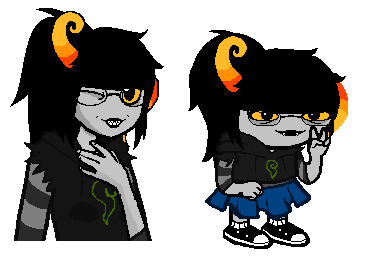
Name: Wyllow Pannim
Age: 10 sweeps
Height: 5'3"
Sign: Will o’ the wisp
Caste: Olive
Classpect: Heir of Space
Lusus: Doe with large antlers, and a snake-like back half.
Personality: Sweet/kind to a fault, puts others’ feelings before her own, is rather shy, doesn’t like crowds. Has trouble standing up for herself but will easily stand up and defend others.
Likes: Plants, gardening, botany, making tea, making anything with things she grows, the supernatural, the paranormal, the occult, horror movies, her quadmates.
Dislikes: Seeing her friends, quadrantmates, or ANYONE upset, being made fun of, normal things to dislike really.
Typing Quirk: Fairly perfect grammar and syntax, types in all lowercase, no punctuation except for ellipses, exclamation points, and question marks, replaces “A” with “@” to be like her sign. Uses ~ as the tail-end of sentences. Stutters a little unless she’s excited or comfortable.
Matesprit: N/A
Moirail: Galekh (askgalekhxigisi)
Kismesis: N/A
Auspistice: N/A
———————————–
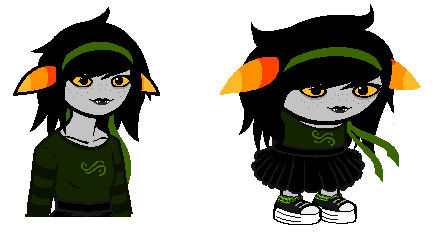
Name: Anaisa Agneau
Age: 10 sweeps
Height: 5'3"
Sign: Canittanius
Caste: Olive (Is actually lime)
Lusus: Female Dorset w/ four horns
Personality: Somewhat nervous around highbloods, acts like a total hardass to guard herself from her squishy, squishy heart, actually flusters pretty easily and hates it.
Likes: Knitting, interior decorating, gifts, singing, finding small quiet places to contemplate life, Just Gothic Things
Dislikes: Large crowds, people being overly nosy, CLOWNS, having her hair long, life in general
Typing Quirk: Prefix and suffix sentences with \ and / to represent knitting needles, doubles “A” to “AA”, all lowercase, fairly good syntax, uses punctuation.
Matesprit: N/A
Moirail: N/A
Kismesis: N/A
Auspistice: N/A
———————————–

Name: Rivera Vulpis
Age: 9 sweeps
Height: 5'3"
Sign: Caprilo
Caste: Purple
Classpect: Witch of Heart
Lusus: A pony-sized fox/dolphix hybrid
Personality: Happy-go-lucky, hard to bring down, blissfully oblivious to certain things, loves to party, throw parties, have parties, is ecstatic to make friends, just an overall chill gal.
Likes: Faygo, juggling, acrobatics, meeting new people, teaching young clowns things she knows, going to clown church, seafox mom.
Dislikes: Not a whole lot. Except maybe being made fun of or no one showing up to her parties.
Typing Quirk: All lowercase except for proper nouns, very lax grammar and syntax, replaces “G” in every word ending in “ing” with a apostrophe. Prefix: ~=* and suffix: *=~ with sentences ending with an exclamation point or two question marks. Uses zalgo text in brief glimpses of “madness”.
Matesprit: N/A
Moirail: N/A
Kismesis: N/A
Auspistice: N/A
——————————
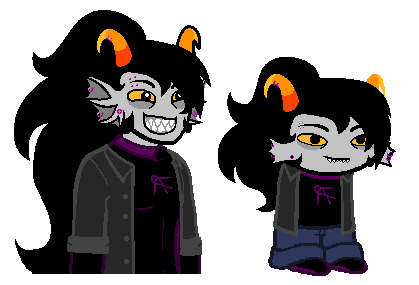
Name: Keyser Volans
Age: 11 Sweeps
Height: 6'2"
Sign: Volans
Caste: Violet
Lusus: A flying fish with feathered wings.(Deceased)
Personality: Fairly laid-back, friendlier than most seadwellers, isn’t super materialistic, very helpful, is just trying to live one day at a time, can get a sass-streak going if wound up enough.
Likes: To surf, play guitar(is fairly good), building sandcastles, piercings(Has 10 so far!), sitcoms, cooking, exploring further inland.
Dislikes: Drones, society, himself, his inherited wealth, his inherited power, everything that comes with being a violet.
Typing Quirk: Prefix: ~^^ and suffix: ^^~ to simulate waves, or positivity, Fairly good syntax/grammar, casual use of nautical/fish puns, uses punctuation.
Matesprit: N/A
Moirail: N/A
Kismesis: Vierya
Auspistice: N/A
—————————–

Name: Vierya Aragan
Age: 12 sweeps
Height: 6'6"
Sign: Aquiun
Caste: Violet
Lusus: Large orca
Personality: Overly confident, Ego as big as the sun, isn’t as big of a basshole as he makes himself out to be. Is easier to become friends with seadwellers than landdwellers, is only snippy on first meeting, can be a bit of a diva and a thot.
Likes: Singing, working at the club, socializing surprisingly, getting into pitch shenanigans, dressing up, looking fabulous.
Dislikes: Swimming, surprisingly, being called a twink/bottom/sub, being put in an uncomfortable position, wrong accusations, gaudy fashion.
Typing Quirk: all lowercase, except for “M” “E” and “I” which are always uppercase, fairly alright grammar and syntax, uses punctuation, replaces “V” with “^” to match his sign.
Matesprit: N/A
Moirail: N/A
Kismesis: Keyser
Auspistice: N/A
——————————–

Name: Aether Mertus
Age: 15 sweeps
Sign: Caprigo
Height: 7'3"
Caste: Purple
Lusus: ???
Personality: Highly charismatic, flirtatious but respects boundaries, seems friendly enough but something always seems a bit “off”.
Likes: Singing, running his club, socializing, absolutely nothing that involves mafia-work.
Dislikes: Very little.
Typing Quirk: all lowercase, except for “W” “U” “B” and “D” which are all uppercase, replaces “C” with “(”, really lax grammar/syntax, suffixes with various “8o)” emojies to go with what mood he’s trying to convey.
Matesprit: N/A
Moirail: N/A
Kismesis: N/A
Auspistice: N/A
———————–

Name: Darian Sincla
Age: 11 Sweeps
Sign: Sagisci
Caste: Indigo
Height: 7'0"
Classpect: ??? of Life
Lusus: Draft Horsedad
Personality: Rather laid back, not one to hide away his feelings, can be a tad blunt but otherwise means well.
Likes: Conspiracies, is somewhat of a true crime buff, bartending, almost anything theatre: dance, ballet, musicals, you name it. He also loves talent tv like Slam or Get Culled and Alternia’s Got Talent or Else.
Dislikes: Being shirtless in any sort of form, anyone finding out about his guilty pleasures.
Typing Quirk: Prefixes sentences with /| and suffixes with |\, Fairly good syntax, capitalizes “L”
Matesprit: N/A
Moirail: N/A
Kismesis: N/A
Auspistice: N/A
————————-

Name: Vikora Desdin
Age: 10 Sweeps
Sign: Aquarist
Caste: Violet
Height: 6′8″
Classpect: ??? of Time
Lusus: N/A
Personality: Rather honeyed with his words, often choosing them carefully. Has a surprising calm, alluring aura around him.
Likes: Reading, artisan cooking(or the aspiration to), sleeping, singing, moonbathing.
Dislikes: <WIP>
Typing Quirk: Prefixes and suffixes sentences with “sSs”, elongates his “S"s (except the “S” in “Sh” words), replaces soft-sounding “C” with elongated “S"s, lowercases everything but nouns, otherwise fairly good syntax.
Matesprit: N/A
Moirail: N/A
Kismesis: N/A
Auspistice: N/A
————————-
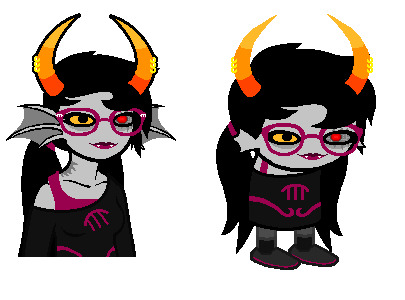
Name: Seaell Haddock (See-ehl Hahd-dohk)
Age: 10 sweeps
Sign: Picorn
Caste: Fuschia
Height: 4'9"
Classpect: ??? of Rage
Lusus: One lone cuttlefish
Personality: Bubbly, Can be a bit snarky and sarcastic, Almost not afraid to speak her mind unless it winds up threatening her life, isn't super pushy.
Likes: Swimming, k-pop, tending to her underwater garden, keeping mostly to herself.
Dislikes: nosy people, asparagus, being made fun of for her height, being asked about her eye, sleeping.
Typing Quirk: Prefixes every sentence with an emoji, preferably “:)” fairly good syntax, tends to CAPITALIZE WHAT’S IMPORTANT and fish puns to her heart’s content.
Matesprit: N/A
Moirail: N/A
Kismesis: N/A
Auspistice: N/A
————————————

Name: Kaycie Lenett
Age: 9 Sweeps
Sign: Gemcen
Caste: Gold
Height: 5'8"
Classpect: ??? of Blood
Lusus: Large Firefly
Personality: Oftentimes cynical and contrary, will argue when it comes to certain topics but is otherwise chill overall. She just seems to radiate bitterness, though. Unless she’s in front of a mixboard and turntables. She also radiates heavy raver aesthetic.
Likes: Heavy beats, mixing her own music, bright neon colors(lights, glowsticks, etc.), ignoring her problems until’ they’re too big to ignore.
Dislikes: Seadwellers
Typing Quirk: Replaces: Soft “C” with “th”, “th” with “D” or “ff”, “S” with “th”, “H"s in “sh” and “ch” elongated to “hhh”, syntax is..i don’t even know. Structures every sentence like a tracklist.
Matesprit: N/A
Moirail: N/A
Kismesis: N/A
Auspistice: N/A
———————————–

Name: Floret Emacie
Age: 10 Sweeps
Sign: Capricer
Caste: Purple
Height: 6'5” (Slouched), 6'8" (Upright)
Classpect: ??? of Blood
Lusus: Large Pitbull/bulldog lusus, named Mr. Nibblez
Personality: Pretty quiet, but always seems to have a dopey smile on his face(though with teeth like those, it always looks dopey), just content to be existing.
Likes: Being Aether’s bouncer, a good faygo, Exotic Meats™
Dislikes: Also seadwellers, super loud noises
Typing quirk: Replaces “th” with “d”, everything uppercase.
Matesprit: N/A
Moirail: N/A
Kismesis: N/A
Auspistice: N/A
—————————-
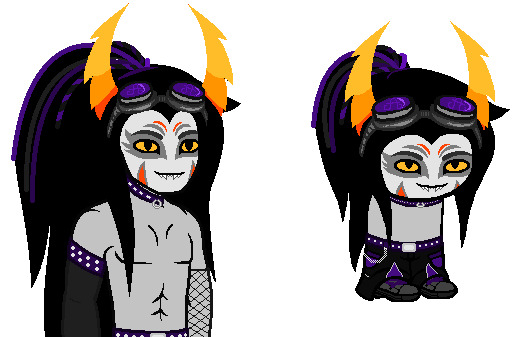
Name: Adrian Vexxin
Age: 10 Sweeps
Sign: Capries
Caste: Purple
Height: 7′3″
Classpect: ??? of Time
Lusus: sealeopard
Personality: A troll of few words and somewhat keeps to himself, mostly. Has a deep devotion to his quadrants, as observed by his interaction with his moirail, Bawxie. Loves to tinker and is constantly working on SOMETHING weapon-esque.
Likes: His moirail, creating new and inventive weapons, The old ways of the Mirthful Messiahs.
Dislikes: The new ways of the Mirthful Messiahs, sometimes lowbloods, heretics, non-believers.
Typing Quirk: Prefix and suffix with “…” RARELY uses full-on sentences and everything is lowercase
Matesprit: N/A
Moirail: Bawxie Calgir
Auspistice: N/A
Kismesis: N/A
————————-

Name: Bawxie Calgir
Age: 9 sweeps
Sign: Capripia
Caste: Purple
Height: 5′8″
Classpect: ??? of Light
Lusus: hippocampus
Personality: Her personality is what most would consider “strong”. She’s loud, bubbly, excitable, and damn-near hyper. To her, there is no cringe culture. She embraces Bold and Random and LOVES troll Invader Zim.
Likes: Troll Invader Zim, her moirail, kandi bracelets, anything sparkly, the Mirthful Messiahs.
Dislikes: When Adrian gets too murderous, being bored, show-ruiners.
Typing Quirk: The language of Scenecore: Plenty useage of emoticons, replaces “s” with “z” on words that end in “s”, throws proper spelling “2 dah WYNDZ! XD” and uses almost no punctuation.
Matesprit: N/A
Moirail: Adrian Vexxin
Auspistice: N/A
Kismesis: N/A
————————————————-

Name: Nyxxia Velour
Age: 20 Sweeps
Sign: Viries
Caste: Jade (Physical mutant”
Height: 6′7″ head to tail
Classpect: ??? of Time
Lusus: None
Personality: In spite of her appearance, she’s rather gentle and warm with those who don’t pose a threat to her or her brood. As the actual leader of the caverns, Nyxxia seems to hold a powerful aura about her, coordinating her caverns with precision and help from her confidant, Alarra.
Likes: Poetry, cinema, her brood, cooking, reading
Dislikes: Being dead
Matesprit: N/A
Moirail: N/A
Kismesis: N/A
Auspistice: N/A
——————————————-

Name: Alarra Vernon
Age: 10 sweeps
Sign: Viricorn
Caste: Jade
Height: 6′0″
Classpect: ??? of Rage
Lusus: None
Personality: As the cavern’s de facto leader, Alarra holds herself to high regard. She’s fairly confident and also fairly skilled at bullshitting her way through a lie. Ask any jade in the cavern, though, and they’ll tell you that she’s almost protective to a fault. Any troll not familiar to her are immediately placed under a scrutinizing gaze, wary and ready to kick ass at a moment’s notice.
Likes: <WIP>
Dislikes: <WIP>
Matesprit: N/A
Moirail: N/A
Kismesis: N/A
Auspistice: N/A
18 notes
·
View notes
Text
Book Review: The Liberation of Sita by Volga (translated by T. Vijay Kumar and C. Vijayasree)
I wanted to read something translated from Telugu and Volga was one of the artists that I happened to come across first. Initially, I thought, wow, what an exotic pseudonym she has chosen for herself. It was the name of her elder sister who died when the author was sixteen.
It’s a lovely little book. The author highlights the problematic instances of the Ramayana, imagines how Sita’s conversations with the characters might have taken place, and traces her subsequent personal growth to liberation. Mild spoilers ahead, but the story itself if not inherently important here, but it’s themes and the way the author has tackled the concept that carry the book.
You’ll find Surpanakha, who had her face disfigured because she was a little horny. She’s now living her life to the full, with a magnificent garden and a handsome boyfriend. There’s Renuka, whose husband ordered his kids to kill her because she got horny (I’m sensing a pattern here). One of the kids, an avatar of Vishnu called Parshuram, decided to obey his father. There’s also some resurrection involved after though. The author imagines what Urmila, Lakshmana’s wife might have gone through, seeing her husband go into exile due to his unwavering allegiance to his brother. Without sparing any thought for her. She gets depressed, locks herself up, and consequently achieves enlightenment. And then there’s Ahalya. Wife of a sage, Indra haves sex with her while disguised as her sage husband, shenanigans and punishments follow. Volga focuses on her treatment, and how it does not matter whether she knew that it was Indra or not, with respect to the harsh judgement that she faced from society.
All of this is framed in the context of Sita and her devotion to Rama. The novella, despite being a fairly short read, covers all the beats of the Ramayana, from the beginning to the end. We see all the hardships that Sita had to endure, and how all the women above helped her cope with it. While vast sections of the society continue to push the dominant narrative, it is refreshing to see the other side of these “epics”. Only in recent times. I have come across works that highlight the various instances of misogyny and casteism in these works. The Ramayana, as told to most kids, tends to end at Diwali, with “good” triumphing over “evil”. When I read an abridged English translation with the complete story, I was shocked to learn about the events that transpire after the war is over, and how terribly Sita is treated by Rama and the society.
Amid all this, I have only one criticism, a major one at that. The translation has not been done properly, and hence the prose is sterile. So while I am thankful to the translators for introducing this gem of a work to a wider audience, I wish there was a better translation that perhaps captured more of the original Telugu prose, which I would like to assume is more lyrical. At least it isn’t in first person. I read it during the Diwali weekend, and would recommend that you do the same.
Tata, bye-bye, shubratri.
0 notes
Link
The journey of Mahatma Gandhi, the father of the nation is well documented. However, in his shadow lived another Gandhi, who was his pillar of support, his constant companion, his wife, the lesser celebrated Gandhi, Kasturba Gandhi. Besides the iconic Kasturba Gandhi road near Connaught Place in Delhi she is relegated to oblivion in the bins of history. Today marks her 77th death anniversary and hence we decided to have a relook at her life.
Early life Kasturba Gandhi, also known as Kasturba Gokuldas Kapadia was born in a wealthy merchant family to Gokuldas Kapadia and Vrajkunwerba Kapadia in the city of Porbandar on 11th April, 1869. Her family and Mohandas’ family were close friends. Kasturba and Mohandas were engaged at a very young age and were married in 1882, when both of them were just 13.
In his autobiography, Gandhi wrote “I do not think it meant to me anything more than the prospect of wearing good clothes, beating drums, marriage processions, rich dinners and a strange girl to play with. Little did I dream that one day I should severely criticize my father for having married me as a child? ” He has written that he was a jealous husband and tried restricting Kasturba. However, she was free - spirited and his efforts went in vain. According to Historian Vinay Lal, “Kasturba never acceded her husband's wishes easily, and Gandhi's autobiography itself furnishes remarkable testimony to her tenacity and independence of judgement, and the sharp disagreements she came to have with him when, in the first two decades of their marriage, he unreasonably sought to bring her under his control.” Although she did not receive a formal education, she was always a keen learner.
Activism
Kasturba’s first involvement in politics and activism was in 1904 in South Africa. There she helped in establishing Phoenix settlement near Durban. In 1913, she was arrested for participating in protests against the ill-treatment of Indian immigrants in South Africa.
Even though she was suffering from chronic bronchitis due to complications at birth, she actively participated in civil actions and even used to take her husband’s spot when he was in prison.
During 1917, in Champaran when Mohandas was working for the plight of Indigo farmers, Kasturba worked for women welfare and taught them about hygiene, health, reading and writing. In 1922, she took part in the famous Satyagraha movement in Borsad, Gujarat.
She even advocated for women and took part in non-violent protests against the British Rule in 1939 in Rajkot. She was even arrested on various occasions. She was a front liner in the Civil Disobedience movement and Quit India movement. Her social work was not only confined to the freedom movement. She also laid her voice against casteism and the practice of untouchability.
In 1942, she participated in the Quit India movement and was again arrested along with Mohandas and other freedom fighters. After this, they were imprisoned in Aga Khan Palace in Pune, where her health deteriorated further and she finally succumbed to death on 22nd February 1944.
Gandhi in his autobiography wrote, “According to my earlier experience, she was very obstinate. In spite of all my pressure she would do as she wished. This led to short or long periods of estrangement between us. However, as my public life expanded, my wife bloomed forth and deliberately lost herself in my work.”
Her work, dedication, tremendous willpower and contribution in the freedom of India cannot be overlooked. Gandhi in his autobiography writes about her, “If anything she stood above me. But for her unfailing co-operation I might have been in the abyss. She helped me to keep wide awake and true to my vows. She stood by me in all my political fights and never hesitated to take the plunge. In the current sense of the word, she was uneducated; however, to my mind she was a model of true education.”
Kasturba was a role model for women at that time and her work and determination is still inspiring. Sarojini Naidu described her as “The living symbol of Indian womanhood”, and rightly so. Instead of knowing her only as Gandhi’s wife, we should remember and appreciate her for her wonderful display of courage and her part in Indian freedom struggle.
0 notes
Text
A Bhopal-based project is working with persecuted denotified tribes to bring in much-needed legal interventions
Tasveer Parmar remembers the first time he was taken to the police station: He was slapped awake by a policeman in the night, and along with his father and a few other members of his family arrested on the charge of theft. This was while his school exams were on. He was 13. The children were sent to the juvenile home, where they were beaten. The beatings in juvenile shelter homes are worse than in the police station, says Tasveer. After eight days they were finally released. A complaint with the State Child Rights Commission was dismissed some years later.
Tasveer, now an adult, and working with NGO Muskaan that’s focussed on providing education to children in Bhopal, says there is no child from his community — Pardhi — who hasn’t seen the inside of a police station. Pardhis are a denotified tribe, among India’s many, and carry the colonial era stigma of being habitual criminals.
In 1871, the colonial British government passed the Criminal Tribes Act — a legislation that allowed for entire communities to be branded as criminals. The reasoning, it’s been speculated, was based in casteism, with its rigid hierarchies and understandings of caste occupations. The communities labelled criminals were often nomadic or socially marginalised.
Since they were believed to be “born with criminal mindsets”, they were in need of stricter policing. The Act subjected them to broad surveillance: roll call, searches of their residences, the authorities had the power to remove ‘contrivances for enabling the residents... to conceal stolen property’; their movement was severely restricted, and state governments had the power to move them to “reformatory settlements”.
The numbers of these criminal tribes were not fixed either. According to the Idate Commission report of 2017, from eight communities in 1871, the list of criminal tribes grew to 200 by 1924. The 1891-92 report on the Administration of Punjab listed 246 names in the register for criminal tribes, in the report from 1892-93 this number had reduced to 243, and the following year to 221. The increase owed mostly to three factors: amendments to the CTA, enactment all over British India (by 1911), and criminalisation of professions.
In 1952, the Indian government repealed the 1871 legislation leading to these communities' classification as “denotified” tribes. Despite this, the stigma of crime has carried far beyond its expiration date, continuing in the present, colouring also their future. This is in no small part due to the ambiguous message of the state governments, which repealed the CTA, only to replace it with new laws for “habitual offenders”. In a Twitter thread, historian Sarah Gandee has written that the laws essentially define a habitual offender as a person who has been sentenced for two or three offences. “This included sec 110 of CrPC (i.e. “bad livelihood”, including the vague “offence” of being “so desperate and dangerous” as to make one “hazardous to the community”). In other words, you could be declared a HO even if you had not committed a crime, but you had been deemed a threat to society. Like the CTA (Criminal Tribes Act), this placed huge discretion in hands of local officials and worked along lines of prejudice.”
“When it comes to these communities, the police largely rely on this narrative of them being criminalised so minors are picked up. Eight or nine year olds are picked up for theft, that’s how the run in with the criminal justice system begins, it starts very early,” says Nikita Sonovane. Sonovane and Ameya Bokil, lawyers based in Bhopal, have started the Criminal Justice and Police Accountability Project (CPAProject) — a research and litigation intervention against criminalisation of communities and on decarceration. They have worked largely with the Pardhi community. Their new initiative is aimed at denotified tribes, as well as other communities that are similarly persecuted and stigmatised by the criminal justice system.
An illustration of the systemic faults in the treatment of these communities is provided by Indramal Bai’s case. In November 2017, Indramal Bai, a scrap dealer in Bhopal, tried to immolate herself following frequent and unrelenting harassment by the police for bribes. Bokil says: “We saw this as an institutional murder. I was involved in the case from the beginning and we both saw it through the fight in the High Court.” He says the police first refused to register the offence against the policemen. “They carried out a pre-investigation enquiry absolving the policemen during which, they forged hospital records, suppressed crucial evidence, got people from Bajrang Dal/ VHP to give irrelevant testimony about how the Pardhis are criminals”.
The police also gave a statement to the press that she was a criminal and that she was drunk; and said in open court that Pardhis are criminals. They “brought up records of her ‘criminal antecedents’ i.e. records of previous cases against her, as if that justified her death”, and “suppressed the details about the cases because she had been acquitted of all but one case. The one case was still pending.” But in this case, owing perhaps also to widespread protests, the High Court ordered a CBI inquiry into the incident.
Tasveer cites another case of Tinti Bai, a 14-year-old Pardhi who committed suicide following harassment from the police. According to a report: “An investigation by the MP Human Rights Commission also concluded that the accused police personnel should be booked for instigating her suicide and that compensation be paid to the family. However, since the commission is only a recommendatory body, these conclusions could only serve as the basis for a police investigation, which was begun, but never concluded. Tinti Bai’s family members and neighbours gave several rounds of testimonies, only to find no resolution or justice at the end of it all.” Tasveer says 10 years later the policeman who was held responsible for her death was promoted and no action of any consequence was taken.
There are no constitutional provisions for the protection of denotified tribes, nomadic and semi nomadic communities. Even the exact numbers of these communities is not known. The latest attempt — by the Idate Commission — had to rely on older reports and consultations to prepare a list, since funding to do a pan India survey was denied. Their status differs from Scheduled Caste, to Scheduled Tribe, to OBC from state to state and in some states from district to district. In Madhya Pradesh, the Pardhis are SC in one district, ST in another, and fall in the general category in Bhopal. The Banjaras are SC in Delhi, ST in Rajasthan, and OBC in Uttar Pradesh. The report also states: “lt was observed during the field visits that different generations of same community have been issued different community certificates, for example in Tamil Nadu, a case come to the notice of the Commission where the grandfather was holding a certificate of SC community while the father was given ST certificate and the son had a certificate of Denotified Community.”
In the 2019 budget it was announced that a committee would be set up under the Niti Ayog to identify and classify statewise the denotified, semi nomadic and nomadic tribes. A task that the Idate Commission had failed, though the commission report repeatedly states the lack of funds that led to planned field visits being cancelled. In 2020’s budget there was no mention of the DNTS, SNTs, and NTs. The recommendations of the Renke Commission (2008) and Idate Commission have not been enacted.
Identification has been a major hurdle in providing welfare to these groups. An analysis of the budget for the schemes for the development of the DNTs across six years shows a slow growth: “While the budget slightly increased in 2018-19 — Rs 10 crore from Rs 6 crore, it has been stagnant since then. It was significant to note that the actual expenditure for each year has been below the budgetary allocation, showing the inability of DNTs to avail of funds and resources meant for them.”
This disarray extends to the laws that target these communities. Their traditional occupations have been rendered illegal, there is little acceptance in society, and their existence on the margins also faces frequent harassment by the police. “The psychological stress is high and reactionary suicides are frequent,” says Pallav Thudgar, who has been working with these communities for the past 15 years, most of it with Muskaan. He says that earlier people consumed DDT to kill themselves, these days hangings have become the preferred method. “This narrative that they are thieves has existed since 1871; what now, what is being done to rehabilitate them? The jungles have been taken from them, they are not allowed space in the market to do any trade, no one wants to hire them, the garbage picking doesn’t make them enough money to survive, what should they do?” In the lack of any other means, many of them have turned to collecting scrap that earns them about Rs 150 a day, surviving on their day-to-day earnings.
Thudgar says these communities are so weak, they have no political clout and can’t fight for themselves. They live in ghettos, aren’t accepted outside, and can’t even find a spot on the road for work. “Woh kalpana bhi nahi kar sakta ek dukaan lagane ki. (They can’t even imagine putting up a small shop).”
Bokil and Sonovane talk of the rigidity of the system when it comes to these communities, that their main struggle has been to just have procedures followed. Besides the police, the response of lawyers needs to be examined as well. Sonovane says, “There is a major gap in terms of the sort of access they have to legal representation. When someone is picked up, there is a certain procedure of law — they are required to be produced in a court within 24 hours. A minor is not even supposed to be kept in police detention, they are supposed to be sent to the observation home. All of these procedures are flouted… There’ll hardly be a Pardhi family that is not dealing with a criminal case, so there is heavy dependence on lawyers because that’s how frequent their run in with the criminal justice system is.”
“The lawyers in this case are largely brokers, they are the middlemen between the police and the judicial system, that’s the role they have been playing because mostly everybody is convinced of the criminality of these people. Nobody wants to take their case because it’s understood ‘Pardhis to chori karate hi hai’ and the police exploits this belief. If there has been a theft and they don’t know who to pick up, they’ll go to the Pardhi locality, pick someone up and pin it on them — men, women, children, anyone,” Sonovane notes.
“The matter of legal representation doesn’t come up until the matter goes to court, but there is a lot that happens in the interim period between when someone is arrested and produced before the court. They are subjected to torture, very often the matter doesn’t even reach the court because the FIR isn’t registered, because families are coerced into paying money, and during this time the accused person has no legal representation whatsoever. This is a question that only comes up when someone is produced in court and when it reaches that stage also, legal representation is largely limited to securing bail, which in itself is another exploitative system because people are required to furnish assets as surety to secure bail which a lot of people don’t have, in which case lawyers act as middle men to procure state surety, so people are released on bail. When we started working these challenges were largely about the police but also to deal with this lawyering response of a kind... that only emerged in a particular space and to navigate that space has and continues to remain a challenge. Also, it is very evident to us that certain communities are targeted under certain laws, but there is no data to back that up, so that is still a vacuum.”
Many of these communities were dependent on forests and wildlife for their livelihood. The Wildlife Protection Act and Prevention of Cruelty to Animals Act has directly affected their livelihoods. Communities such as the sapera, madari, qalandar, have had their traditional occupations taken away under these Acts but no rehabilitation has been provided for them. The Pardhis are known to hunt teetar (partridge) which is not an endangered species or even close to the brink, but hunting them can earn a prison sentence of three to six years. Tasveer responds, “Aapke liye janwar itna important hai, par insaan ki jaan ki koi importance nahi hai? (There is such concern for animals, but what of human beings?)”
A survey of the data on environmental crimes as reported by the National Crime Records Bureau reveals the lopsided use of these acts against the poor and vulnerable.
Besides the criminal law provisions like theft and dacoity which are commonly deployed against these tribes, Sonovane says, legislations like the Arms Act are arbitrarily used against them. Someone in possession of a knife is booked under it; Excise Acts, Anti beggary laws, and now even cattle transport laws are used against them.
The CPAProject, besides litigation, will carry out research into the criminal justice processes deployed against these persecuted communities. The project website states: “This would include a study of acts of executive action, arrest, detention, bribe-taking, torture, production, bail, collection of evidence and presentation of evidence before the courts and their decision through an appraisal of the police and court records along with interviews of the accused persons and state actors. In the same manner, we will examine the system’s reception to resistance to these violations whether through complaints or arguments during the court processes. We also intend to study the impact of substantive criminal laws themselves.”
There have been criminal justice interventions, but no legal interventions in the past, say Sonovane and Bokil. Organisations such as Delhi-based Prayaas that works largely with children, and National Law University’s Project 39A, have worked on these issues, but nothing so far has been aimed specifically at the denotified, semi nomadic and nomadic tribes.
A notable judgement though was in the case of Ashok Maruti Shinde vs State of Maharashtra. Six men — Ambadas Laxman Shinde, Bapu Appa Shinde, Ankush Maruti Shinde, Rajya Appa Shinde, Raju Mhasu Shinde and Suresh Nagu Shinde — were convicted for murdering five members of a family of guava pickers in Nashik in Maharashtra in 2003. Ankush Maruti was released in 2012 once it had been established he was a juvenile at the time. The remaining five spent 16 years on death row, until March 2019, when the Supreme Court overturned its own verdict.
The Shindes are Vadars, a subset of the Pardhi tribe. Traditionally they were hunters but have now shifted to stone breaking, collecting scrap, road laying and ditch digging.
Clearing them, the judgement said there had been “no fair and honest investigation”, adding, “we strongly deprecate the conduct of the police and the prosecution”.
There is a sense of the resistance within the community growing. In 2014, the National Alliance Group for denotified tribes was formed, to work on social, developmental, and cultural aspects, but is now moving towards political engagement. Bokil says, “Women are strong in the resistance. There is this courage… Indramal Bai’s death was followed by months of protests, for a month, people put up tents and stayed there… There are others using art, lots of people writing poetry. Indramal Bai’s case was also made into a play… the mobilisation for Indramal Bai led to lesser discrimination in that jurisdiction at least”.
***
Key snapshots from National Commission for Denotified, Nomadic and Semi-Nomadic Tribes report:
via Blogger https://ift.tt/2WaqWl8
0 notes
Text
7 Of Bollywood’s Most Under-rated Masterpieces
New Post has been published on https://healingawerness.com/getting-healthy/getting-healthy-women/7-of-bollywoods-most-under-rated-masterpieces/
7 Of Bollywood’s Most Under-rated Masterpieces
While many people define the success of a film by the money it makes at the box office, there’s a lot more to it. Many times, brilliant movies are overlooked by the fact that they didn’t star big shot actors or aren’t directed by a big name in the industry. And in some cases, movies are overlooked for simply discussing topics that might not be considered mainstream. So we at StyleCraze decided to compile a list of 7 under-rated Bollywood masterpieces from the past two decades.
1. Iqbal (2005)
anumit_01 / Instagram
Shreyas Talpade plays the titular role of Iqbal, a deaf and mute boy born in a poor agrarian family. He dreams of being a cricketer but his father isn’t so keen on his dreams and wants him to take on the family profession and toil the land. Luckily for Iqbal, he has the support of his mother and younger sister. Eventually, his skills are noticed by a washed-up, alcoholic, ex cricket player and the story ensues. This movie is a must-watch for all those who are passionate about cricket.
2. Margarita With A Straw (2015)
lgbtkerala / Instagram
Margarita With A Straw is a beautiful movie about self-realization, self-actualization, and self-discovery. It deals with a young woman suffering from cerebral palsy who rebels against her family to pursue her dreams of studying in New York City. While in New York, she meets a blind Bangladeshi-Pakistani woman named Khanoum and the two enter a relationship. This is a beautiful story about love, loss and the bond between a mother and her child. It deals with issues like LGBTQ+ relationships, cheating, cancer and more topics that are considered taboo. We’d recommend keeping the tissues handy. You’re most definitely going to need them after watching this film.
3. Water (2005)
arzu_akay_film_yorumlari / Instagram
Water is a beautiful and empowering tale of widowed women living in an ashram and chronicles their lives throughout the movie. It talks about how women in a pre-independent India were treated as burdens and discarded by their husbands’ families after the deaths of their husbands. We see the movie play out through the eyes of many characters, the most prominent of whom is an 8-year-old girl named Chuyia who was married off to a much older man. Unfortunately, the girl’s “husband” dies right after the wedding and his family, not wanting to take responsibility for her abandons her at the ashram.
4. Delhi Belly (2009)
a_movie_bufff / Instagram
If you thought you had bad luck, you haven’t seen anything yet! Imran Khan plays the character of a broke journalist, Tashi, who along with his equally broke roommates, Arup and Nitin gets embroiled in the games of a Delhi gangster. What ensues is a hilarious series of misunderstandings that can only occur in a city like Delhi. Delhi Belly goes from high-speed car chases to Mexican standoffs to 80s styled musical numbers to innuendo and double entendre filled humor in the span of a heartbeat.
5. Dasvidaniya (2008)
Source: Twitter
Dasvidaniya follows the story of a 37-year-old middle-class accounts manager named Amar Kaul who works at a pharmaceutical company. His life is flipped over when his upset stomach turns out to be stage three cancer and he makes a bucket list of all the things he wants to do before he dies. This list ranges from confessing his feelings for a colleague to getting back at his boss for treating him badly to visiting his friend in Russia.
6. Masaan (2015)
bongg.bayy / Instagram
Masaan involves two stories. The first one is of a father-daughter relationship that is tormented by a bad decision on the daughter’s part that leads to them being ostracized by the conservative society that they live in. And the second one is an inter-caste relationship set against the banks of the river Ganges. The film talks about what it’s like growing up in a conservative area like Varanasi and deals with the corruption of cops, mistreatment of minors, casteism and many other important topics. Richa Chadha and Vicky Kaushal play lead characters in the movie and are both subjected to various degrees of mental torture throughout their stories.
7. Khosla Ka Ghosla (2006)
anugoonjmedia / Instagram
The movie starts with an oddly hilarious scene of the lead character, Khosla dreaming about his death. The irony of the dream is that neither his family nor his neighbors care about his death as much as their own selfish and materialistic needs. Khosla sees this as a wake-up call and plans on building a house for himself. Unfortunately for Khosla, he finds out he has been duped by the property seller and someone else has claimed his plot of land. On further investigation, he encounters the scrupulous character of Kishan Khurana and what ensues is a mind-bending game of the most hilarious variety.
Some of the movies on this list did receive praise for their treatment of topics that were considered taboo in our society, but these movies didn’t create as much of a ruckus during their release as they should have. What are your thoughts on this list and what is the one most underrated movie you’ve ever watched? Let us know in the comments below.
Was this article helpful?
Related
The following two tabs change content below.
Niharika has a passion for all things art, music and travel. During her spare time she likes experimenting in the kitchen, painting pop culture icons and chasing after random street cats. Her dream is to one day own an amusement park so she can ride roller coasters for free.
LATEST ARTICLES
Source: https://www.stylecraze.com/trending/bollywoods-under-rated-masterpieces/
0 notes
Text
Payal Tadvi's suicide exposes how under-representation of Dalits, Adivasis, caste discrimination have an effect on greater training institutes
http://tinyurl.com/y67kjuj4 The ‘suicide’ of Dr Payal Tadvi is the newest in a long list of lives taken by caste and institutional collusion towards Dalits and Adivasis. The gross under-representation of Dalits and Adivasis at each stage in institutes of upper training and ubiquity of caste-based discrimination in these areas go hand in hand. Every occasion of discrimination, atrocity, and harassment that performs out on tutorial campuses culminates from abject failure throughout academia to actually confront the difficulty of caste-based violence, however it’s seldom regarded so by these establishments and the individuals operating them. When the violence escalates to the purpose of loss of life, it’s met with disbelief and horror despite the fact that the institutional mechanisms that failed the sufferer, repeatedly, are the identical time and again. But, every case is regarded in isolation, as brought on by errant people/circumstances. What’s to forestall the identical occasions from taking part in out once more in one other (and even the identical) establishment, is a query virtually by no means requested by the bigger tutorial group. Payal Tadvi. Picture/Fb It was this structural violence that the UGC sought to deal with with its tips to advertise fairness by organising of ‘equal opportunity cells’ (EOCs) in each institute of upper training. The paltry implementation of those tips was summarised in a November 2017 report: “Solely 155 universities appeared to have responded to the UGC’s letter (looking for ‘motion taken stories’ on establishing cells to look into caste-based discrimination) for the 12 months 2015-16 (India has about 800 universities). Of them, solely about half had a webpage the place SC/ST college students might lodge complaints of discrimination. Lower than half – 47 percent- had constituted committees or cells particularly meant to look into complaints of discrimination towards SC/ST college students. It’s maybe not shocking then that 87 % of universities reported that that they had obtained zero complaints of caste-based discrimination. Of the 146 complaints that had been obtained, some had been apparently addressed by ‘lectures’, ‘counseling’ and ‘mentorship’.” On this article, we search to have a look at the implementation of EOC tips at establishments deemed to be among the many greatest of their respective domains — engineering, medication, pure science, social science, and administration. Again and again a few of these institutes are celebrated for being on the top in the country, based on national and global rankings. Additionally they obtain a disproportionate quantity of funding, with IITs, IIMs and NITs having 3 percent of total students getting more than 50 percent of government funds. These, and different institutes of excellence/eminence are sometimes exempt from a lot monitoring by the UGC, an autonomy that is widely exclaimed regardless of critical issues over their exclusionary effects. So how properly do these institutes carry out in following the UGC tips for promotion of fairness in greater training institutes? We searched by the web sites of 132 institutes, widespread for various fields of examine, to see if there exists a useful EOC/SC-ST/SC-ST-OBC cell or every other cell that carries out equal capabilities. Though the EOC and SC/ST and OBC cells shouldn’t have precisely the identical mandate; since each cells are involved with broadly comparable targets of grievance redressal, sensitisation on points and promotion of welfare and illustration of minority teams in institutes, we scored the institutes as having one if that they had both. To evaluate the accessibility stage of the cell, we used the next metrics: (i) whether or not the constituent members of the cell are listed on the web site,(ii) whether or not contact data (telephone/electronic mail) of any member or a generic telephone/electronic mail contact is revealed, or a complaints portal is obtainable, with a purpose to make complaints,(iii) whether or not there may be any web page suggesting the existence of an SC/ST and OBC cell or EOC on the institute web site, and,(iv) whether or not the EOC webpage could be accessed in a couple of clicks from the establishment’s house web page. Within the linked spreadsheet, a ‘Y’ showing in each column would point out a better stage of confidence within the functioning of the EOC than in any other case. We see the primary two columns as extra necessary as it is not a lot use if the institute has a cell whose existence or contact particulars stay unknown to the scholars and school. Lastly, we acknowledge that we didn’t have entry to intranet pages and the main points of the committee/cell might have been made accessible there. Nonetheless, we expect that is unlikely as most institutes had particulars of all different cells made accessible on their public webpages and we really feel that the absence of knowledge is sort of possible suggestive of the absence of a committee altogether. We might have mistakenly made omissions throughout our web-searches though we did our greatest to be very thorough. We’re pretty sure that the errors are few and what we report right here is basically reflective of the overall state of affairs concerning EOCs in these esteemed greater training institutes. Of the 132 institutes whose web sites we surveyed, solely 42 had any data that might allow college students or college to entry the EOC/SC-ST Cell or lodge a grievance. Solely 4 of 15 institutes deemed ‘institutes of excellence’ as per the Central Education Institutions (Reservation in Admission) Act, 2006, solely 4 of the 13 IITs (that had been established earlier than 2008), and not one of the six first-generation IIMs had this data. As for the colleges, about 60 % of these surveyed had committees listed or grievance portals on their web site. We didn’t examine the assorted schools hooked up to every college, presumably, the colleges which can be following a protocol are making certain that the universities are doing in order properly. Lastly, it’s worthwhile to notice that the mandate of EOCs was to not be solely to take care of caste-based points however to strategise and oversee anti-discrimination and welfare measures to enhance the illustration of different minorities and deprived teams in these establishments, as properly. Since our focus right here is totally on the difficulty of caste in academia, we didn’t take into account the EOCs in two of the IIMs which we surveyed, that appeared to be solely involved with selling the welfare and illustration of differently-abled people, which is simply part of the mandate of the EOC as acknowledged by UGC. Nonetheless, we do word that in virtually all of the institutes which didn’t have EOCs, there have been no different equal and focused cells for different minorities on the campus both. Our give attention to institutes’ compliance with the rules for EOC, or an equal physique equivalent to an SC/ST cell, shouldn’t be rooted in any lofty hopes that it’ll guarantee both discrimination-free campuses or actually inclusive training. We do not envisage a strong and dedicated EOC being constituted by any of those institutes, their negligence up to now speaks sufficient about their dedication to the difficulty. Casteism performs out in a number of methods and the everydayness of it on this these establishments is hardly curtailed by rules and regulations. To cite from the UGC tips for promotion of fairness in greater training, “the diploma of democratisation of upper training needs to be elevated to a big extent”, and it’s to spotlight the violence perpetuated by these ‘citadels of data’ by their enduring inaction, that we want to elevate this challenge. It’s no shock to us that it was the IITs, IIMs and medical institutes’ students who unleashed the 2006 anti-quota agitations, fomenting an intensely vitriolic local weather for college students belonging to scheduled castes and tribes, throughout campuses. It was within the wake of that violence that the Thorat committee was fashioned to look into allegations of harassment of SC and ST college students at AIIMS. The appalling findings revealing the extent of rampant discrimination confronted by these college students and the corrective suggestions made by the committee led to the UGC tips to type EOCs in institutes of upper training. But, these similar institutes have been apathetic to those tips to sensitise college students (and school) about casteism and structural violence, to plan programmes to reinforce welfare, present redressal for discrimination and harassment, and promote illustration on their campuses. One of many particulars which have surfaced after Payal’s loss of life was that she was harassed on a Whatsapp group. It’s extremely distressing that there was nobody on that group who might rise up for Payal or attain out to assist her and it drives house the necessity for representation by marginalised students to at the very least assist one another survive the default casteism on these campuses. One necessary suggestion made by the Thorat Committee to AIIMS was to have a scholar from the SC/ST class, on each scholar and student-affairs associated committee. This suggestion didn’t develop into a part of the UGC tips. However had it, it might have uncovered the pathetically low enrollment of those college students within the esteemed greater training establishments. The institutes of excellence/nationwide significance, as an example, are exempt from implementing reservations. These institutes, for all of the autonomy that they get pleasure from and their claims of excellence-eminence-national significance, make no try and however fulfill that obligation to society, no matter their being sure or not by the UGC Reservation in Admissions Act. And even to affect academic coverage in such a fashion as to right such perverse conceptions of excellence and nation-building, to which social-justice in not completely central. We’ve got made no makes an attempt to determine whether or not any institutes in our record had been exempt from fulfilling the UGC tips on the creation of EOCs. We don’t suppose it vital as a result of these institutes, of their very own accord, or to adjust to the UGC, needs to be taking extra proactive measures to make their campuses secure, accessible and fulfilling to everybody. They’re in the end answerable to society. In regards to the authors: Abha Jeurkar (PhD researcher at TISS), Ananya Kumar (Christ College), Manish Gautam (alumnus of IIT-Ok & IISc), Ra Ravishankar (alumnus of BITS, Pilani) & Sumithra (Analysis Affiliate at IISc). !function(f,b,e,v,n,t,s) {if(f.fbq)return;n=f.fbq=function() {n.callMethod? n.callMethod.apply(n,arguments):n.queue.push(arguments)} ; if(!f._fbq)f._fbq=n;n.push=n;n.loaded=!0;n.version='2.0'; n.queue=[];t=b.createElement(e);t.async=!0; t.src=v;s=b.getElementsByTagName(e)[0]; s.parentNode.insertBefore(t,s)}(window,document,'script', 'https://connect.facebook.net/en_US/fbevents.js'); fbq('init', '259288058299626'); fbq('track', 'PageView'); (function(d, s, id) { var js, fjs = d.getElementsByTagName(s)[0]; if (d.getElementById(id)) return; js = d.createElement(s); js.id = id; js.src = "http://connect.facebook.net/en_GB/all.js#xfbml=1&version=v2.9&appId=1117108234997285"; fjs.parentNode.insertBefore(js, fjs); }(document, 'script', 'facebook-jssdk')); window.fbAsyncInit = function () { FB.init({appId: '1117108234997285', version: 2.4, xfbml: true}); // *** here is my code *** if (typeof facebookInit == 'function') { facebookInit(); } }; (function () { var e = document.createElement('script'); e.src = document.location.protocol + '//connect.facebook.net/en_US/all.js'; e.async = true; document.getElementById('fb-root').appendChild(e); }()); function facebookInit() { console.log('Found FB: Loading comments.'); FB.XFBML.parse(); } Source link
0 notes